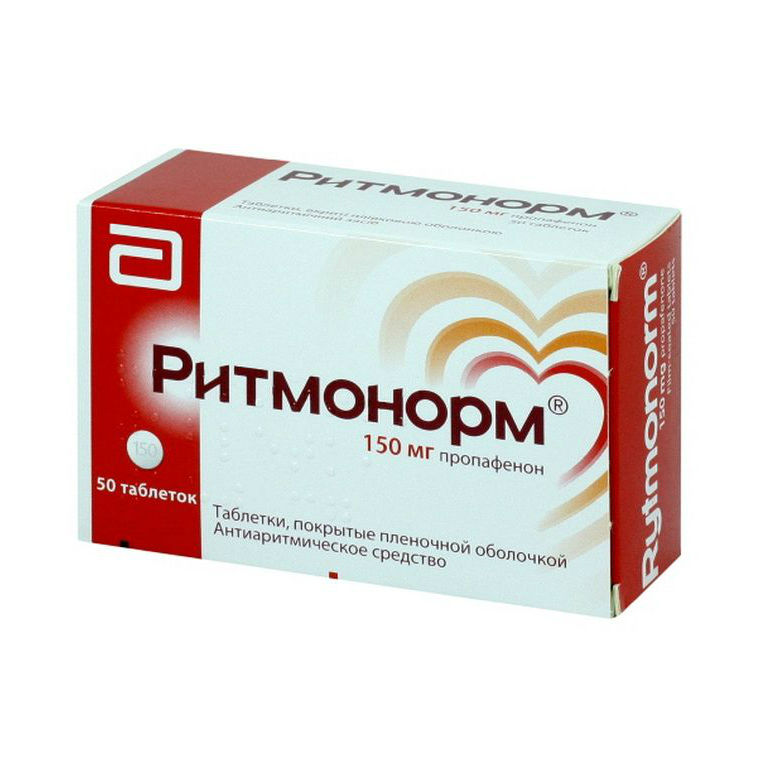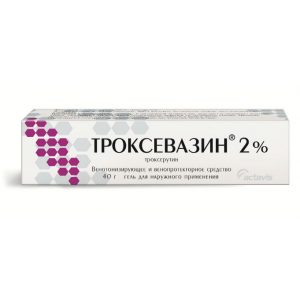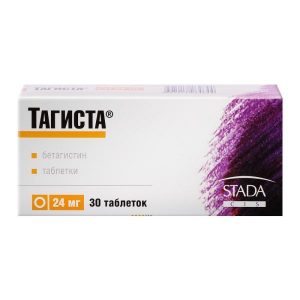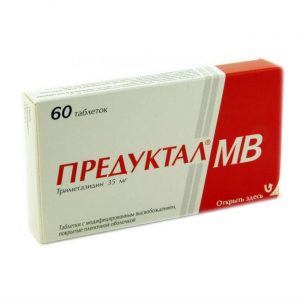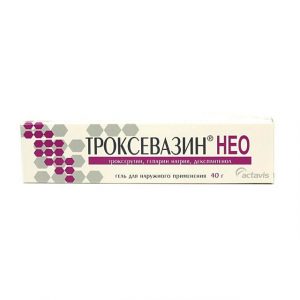Description
release form
Tablets
Packing
50 pcs
Pharmacological action
Propafenone has membrane-stabilizing properties, sodium channel blocker properties (class 1C) and weakly expressed beta-adrenergic blocking activity (class II).
It slows down the growth of action potential, as a result, the speed of the pulse is reduced (negative dromotropic effect). The refractory period in the atrium, atrioventricular (AV) node and ventricles lengthens. Propafenone also lengthens the refractory period in additional conduction pathways in patients with Wolf-Parkinson-White syndrome (WPW).
Pharmacokinetics
Propafenone is a racemic mixture consisting of R-propafenone and S-propafenone.
Absorption
The maximum concentration (Cmax) of the drug in the blood plasma is created in the range from 2 to 3 hours after ingestion. Propafenone undergoes a significant and saturated presystemic biotransformation using the CYP2D6 isoenzyme (the effect of the “primary passage” through the liver), and in this regard, the absolute bioavailability of the drug depends on the dose and dosage form. Although eating caused an increase in bioavailability and plasma Cmax in a single dose study, prolonged use of propafenone with food in healthy volunteers did not lead to a significant change in bioavailability.
Distribution
Propaphenone is rapidly distributed in the body. The volume of distribution in equilibrium is from 1.9 to 3.0 l / kg. The degree of binding of propafenone to plasma proteins depends on the concentration and decreases from 97.3% with a dose of 0.25 ng / ml to 91.3% with a dose of 100 ng / ml.
Metabolism and excretion of
There are two genetically determined pathways of propafenone metabolism. More than 90% of patients have preparations long-term use of propafenone with food in healthy volunteers did not lead to a significant change in bioavailability.
Distribution
Propaphenone is rapidly distributed in the body. The volume of distribution in equilibrium is from 1.9 to 3.0 l / kg. The degree of binding of propafenone to plasma proteins depends on the concentration and decreases from 97.3% with a dose of 0.25 ng / ml to 91.3% with a dose of 100 ng / ml.
Metabolism and excretion of
There are two genetically determined pathways of propafenone metabolism. More than 90% of patients have preparations long-term use of propafenone with food in healthy volunteers did not lead to a significant change in bioavailability.
Distribution
Propaphenone is rapidly distributed in the body. The volume of distribution in equilibrium is from 1.9 to 3.0 l / kg. The degree of binding of propafenone to plasma proteins depends on the concentration and decreases from 97.3% with a dose of 0.25 ng / ml to 91.3% with a dose of 100 ng / ml.
Metabolism and excretion of
There are two genetically determined pathways of propafenone metabolism. More than 90% of patients have preparations 3% with a dose of 0.25 ng / ml to 91.3% with a dose of 100 ng / ml.
Metabolism and excretion of
There are two genetically determined pathways of propafenone metabolism. More than 90% of patients have preparations 3% with a dose of 0.25 ng / ml to 91.3% with a dose of 100 ng / ml.
Metabolism and excretion of
There are two genetically determined pathways of propafenone metabolism. More than 90% of patients have preparationsAt is rapidly and significantly metabolized, the half-life (Tm) is from 2 to 10 hours (the so-called fast metabolizers ). In such patients, propafenone is metabolized to form 2 active metabolites – 5-hydroxypropaphenone using the isoenzyme CYP2D6 and N-dipropylpropaphenone (norpropaphenone ) using isoenzymes CYP3A4 and CYP1A2. In less than 10% of patients, propafenone is metabolized more slowly, since 5-hydroxypropaphenone does not form or is produced in insignificant amounts (the so-called “slow metabolizers”). With this type of metabolism, Tm is from 10 to 32 hours. The clearance of propafenone is from 0.67 to 0.81 l / h / kg. Since the equilibrium state of pharmacokinetic parameters or indicators is achieved 3-4 days after taking the drug in all patients, then the dosage regimen of propafenone is the same for all patients, regardless of metabolic rate ( fast or slow metabolizers).
With significant metabolism with a saturated hydroxylation cycle using the CYP2D6 isoenzyme, the pharmacokinetics of propafenone are nonlinear, and with slow metabolism, they are linear.
The pharmacokinetics of propafenone has significant individual variability, which is mainly due to the effect of the “primary passage” through the liver, as well as the nonlinearity of the pharmacokinetics with significant metabolism. Variability in the concentration of propafenone in the blood requires careful dose titration and observation of clinical and electrocardiographic signs of the drug.
Elderly patients
In elderly patients with normal renal function, the content of propafenone varied greatly and did not significantly differ from that in healthy young patients. The content of 5-hydroxypropaphenone was approximately similar, but the content of propaphenone glucuronides was two times higher.
Impaired renal function
In patients with impaired renal function, the contents of propafenone and 5-hydroxypropaphenone were similar compared to healthy volunteers, but accumulation of glucuronide metabolites was observed. In case of impaired renal function, propafenone should be used with caution.
Impaired liver function
Bioavailability and T when administered increase in patients with impaired liver function. A dose adjustment of propafenone is necessary for impaired liver function.
Indications
Symptomatic, requiring treatment supraventricular tachycardia, incl. with WPW syndrome, or paroxysmal atrial fibrillation. Severe and life-threatening symptomatic ventricular tachycardia.
Contraindications
Severe heart failure, cardiogenic shock (except arrhythmogenic), severe bradycardia, AV and intraventricular conduction disturbances, sinus node weakness syndrome, electrolyte disturbances, obstructive pulmonary disease, hypotension, myasthenia gravis.
Use during pregnancy and lactation
During pregnancy, especially in the first trimester, and during lactation Rhythmorm should be taken only as indicated.
Composition
Each tablet contains:
Active ingredient: Propafenone hydrochloride 150 mg.
Excipients: microcrystalline cellulose -25.40 mg croscarmellose sodium -10.00 mg corn starch – 20.00 mg hypromellose-2910 8.00 mg magnesium stearate – 0.50 mg water – 6.10 mg.
Film coating: macrogol 400 -0.52 mg macrogol 6000 – 4.176 mg hypromellose-2910 – 6.264 mg, titanium dioxide (E 171) – 1.04 mg.
Dosage and administration
Rhythmorm is used orally, after meals, without chewing, with a small amount of liquid. Doses and treatment regimens are selected individually. During the dose selection period and for maintenance therapy, the daily dose is 450-600 mg, the maximum daily dose is 900 mg in 3 divided doses.
Side effects
Possible proarrhythmogenic effect, increased heart failure, orthostatic hypotension, dyspeptic disorders, headache, visual and taste disturbances, fatigue.
Drug interaction
With the combined use of propafenone with local anesthetics (for example, when implanting a pacemaker, during surgical interventions, in dentistry) or other drugs that reduce heart rate and / or reduce myocardial contractility (for example, beta-blockers, tricyclic antidepressants) may increase side effects.
The simultaneous use of propafenone with drugs metabolized by the CYP2D6 isoenzyme (for example, venlafaxine) can cause an increase in the concentration of these drugs in blood plasma. An increase in the concentration of propranolol, metoprolol, desipramine, cyclosporine, theophylline and digoxin in blood plasma can also be observed while taking with propafenone. If necessary, in case of symptoms of an overdose, the doses of these drugs should be reduced.
Drugs that inhibit the isoenzymes of CYP2D6, CYP1A2, CYP3A4, for example, ketoconazole, cimetidine, quinidine, erythromycin and grapefruit juice can cause an increase in the concentration of propafenone in blood plasma. With the simultaneous use of propafenone with inhibitors of these isoenzymes, patients should be closely monitored, if necessary, the dose of the drug should be adjusted.
Combined therapy with amiodarone and propafenone can cause impaired conduction and repolarization, as well as be accompanied by a proarrhythmogenic effect. In this case, a dose adjustment of both drugs may be required.
Although changes in the pharmacokinetics of propafenone and lidocaine were not observed when used together, an increased risk of CNS side effects of lidocaine has been reported.
phenobarbital is an inducer of the isoenzyme CYP3A4, the response to therapy should be monitored if propafenone is added to long-term phenobarbital therapy.
The simultaneous use of propafenone and rifampicin can reduce the concentration of propafenone in blood plasma and, as a result, reduce its antiarrhythmic activity.
It is necessary to control the state of the blood coagulation system in patients simultaneously receiving indirect anticoagulants (fenprocoumon, warfarin), since propafenone can enhance the pharmacological effect of these drugs and cause a prolongation of prothrombin time. If necessary, in case of symptoms of an overdose, the doses of these drugs should be reduced.
When combined with propafenone and selective serotonin reuptake inhibitors (such as fluoxetine or paroxetine), an increase in plasma concentration of propafenone may occur. The combined use of propafenone and fluoxetine in fast metabolizers increases Cmax and AUC of propafenone S by 39% and 50%, and of propafenone R – by 71% and 50%, respectively. Thus, the desired therapeutic effect can be achieved with the use of propafenone in lower doses.
Overdose
Myocardial symptoms of
: consequences of propafenone overdose for myocardium are manifested by such disorders as prolongation of the PQ interval, expansion of the QRS complex, suppression of sinus node automatism, AV blockade, ventricular tachycardia, ventricular fibrillation, ventricular flutter. Reduced contractility (negative inotropic effect) can lead to a marked decrease in BP, which in severe cases can cause collapse.
Extracardial symptoms: headache, dizziness, blurred vision, paresthesia, tremor, nausea, constipation and dryness of the oral mucosa can often be observed. In very rare cases, convulsions have been reported as a result of an overdose. The case of a fatal incident was also reported. In cases of severe poisoning clonic-tonic convulsions, paresthesia, drowsiness, coma and respiratory arrest are possible.
Treatment of
Attempts to remove Rhythmonorm from the body by hemoperfusion are ineffective.
Because propafenone has high Vd and high plasma protein binding (> 95%), hemodialysis is ineffective.
In addition to conducting general emergency activities, it is necessary to monitor vital indicators in the intensive care unit and adjust them as needed.
Defibrillation and dopamine and isoproterenol infusions are effective measures to control heart rate and blood pressure. Seizures are stopped in / in the introduction of diazepam.
General supportive activities, such as connecting to an artificial respiration machine and indirect heart massage, may be required.
Storage Conditions
In a dry, dark place at a temperature not exceeding 25 ° C.
Deystvuyushtee substance
Propafenone
Terms and conditions
prescription
dosage form
tablets
Possible product names
RHYTHMONM 0.15 N50 TABLE P / O
Rhythm. 150g P / o X50 (R)
Rhythmorm 150mg No. 50
Rhythmorm 150mg No. 50 tab
Rhythmorm tab. p / o 150 mg x 50
